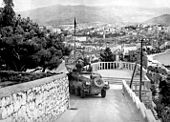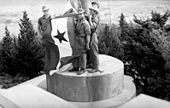History of Split
| History of Dalmatia |
|---|
 |
| History of Croatia |
|---|
 |
| Timeline |
|
|
The city of
Venice eventually prevailed and during the
Antiquity
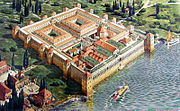
Although the beginnings of Split are traditionally associated with the construction of
The Greek settlement lived off trade with the surrounding
The
The Palace was built as a massive structure, much like a Roman military fortress. It faces the sea on its south side, with its walls 170 to 200 metres (570 to 700 ft) long, and 15 to 20 metres (50 to 70 ft) high, enclosing an area of 38,000 m2 (9½ acres, or about 5.5
The Palace was to have one further significant occupant, however:
Sack of Salona

The history of Split as a significant city, in its own right, begins with the
For the following decade, the Salonitans lived in huts on the islands, suffering from a lack of drinking water (the islands themselves appear to have been mostly deserted by that time). The younger men equipped some light ships and raided Croat settlements on the mainland "so that none of the Slavs dared to go down to the sea".[17] At this point there emerged a leader among the exiles, known only as Severus the Great ("whose house had stood next to the columns of the Palace by the sea"[17]). He persuaded the vast majority of the remaining Salonitans to return to the mainland. They could not return to the ruins of Salona, which were entirely indefensible and closer to the Slavic tribes of the interior, but chose instead to occupy the 300-year-old Palace of Diocletian. They intended to stay in the Palace until such a time as Salona might be reoccupied, but this never became possible. The strong fortifications of the palace, along with its placement directly upon the sea, meant that it could not be effectively besieged by the Slavic tribes of the mainland.[18]
The Salonitans occupied the Palace around the year 650 CE. Their numbers were so reduced by this point that the fortress-like structure, which was not built to serve as a city, was sufficient for their needs. Contrary to their expectations of retaking Salona, the citizens were hard-pressed to maintain themselves even in the Palace. Upon hearing of their return, the Croats destroyed their crops and confined them within the gates. The Emperor Constans II intervened at this point, and granted them an Imperial mandate to establish themselves in the Palace as the City of Spalatum, which imposed upon the Slavs a cessation of further hostilities through diplomatic arrangements.[18] The Empire itself at this time was hard-pressed to defend itself against the Caliphate and the Lombards in Italy, but was at the time in fact allied with the Croatian Slavs against the Avars.
The citizens of Spalatum now purged the
Byzantine period
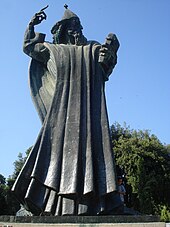
Throughout the following centuries, effectively until the
Dalmatia, or rather the cities, islands, and the immediate coastline, was organized as a Byzantine duchy, administered by the Exarchate of Ravenna. After the final fall of Ravenna to the Lombards in 751, the prefects and fleet fled from Ravenna to the port of Jadera (Zadar), and the Duchy of Dalmatia began to be administered from there. The cities along the coast, however, enjoyed significant privileges and in practice ran their own affairs independently.[19]
In 925, in the hinterland of Spalatro,
Tomislav had his seat at
Medieval overlords of Split, 998–1420 | ||||
980 — – 1000 — – 1020 — – 1040 — – 1060 — – 1080 — – 1100 — – 1120 — – 1140 — – 1160 — – 1180 — – 1200 — – 1220 — – 1240 — – 1260 — – 1280 — – 1300 — – 1320 — – 1340 — – 1360 — – 1380 — – 1400 — – 1420 — – 1440 — | ||||
| ||||
Throughout the 9th and 10th centuries, the waters of the Adriatic were the theatre of a naval struggle between the
In 1014 the
After the death of Croatian King
Struggle for Dalmatia
Split was now a subject of the Venetian Doge, and was, along with Trogir and Zadar, one of the three (major) cities of Dalmatia. At this time the
The rights granted to the city (and reaffirmed by new charters) were substantial. Split was to pay no tribute, it was to choose its own count and archbishop whom the king would confirm, it preserved its old Roman laws, and appointed its own judge. Dues from trade (which were substantial in the period), were divided between the count, the archbishop, and the king, and no foreigner was to live within the walls of the city against the will of the citizens. These rights were generally upheld by Hungarian kings, but there were inevitable incidents of violation. The new Hungarian Archbishop of Split, Manasses, attempted to take control of the city with the aid of the Hungarian garrison (whose presence was in itself a violation of privilege). Headed by Adriano de Treviso, the Count of Split, the citizens rose up, and, with the help of a contingent from Trogir, massacred the garrison and expelled the Archbishop. Some years later, one Reles, referred to as the Duke of Croatia, attempted to gain control over the city by inducing the citizens to elect him their Count, but the citizens refused "out of detestation of being ruled by a Slav".[17] When Reles ravaged their lands the citizens defeated him in battle and killed him.[18]
King Coloman died in 1116, ten years after his conquest, while the Doge Ordelafo Faliero had in the meantime returned from
The cities remained in Venetian hands without contest during the reign of
In that period, however, Split was to see one brief (and final) restoration of Imperial power in Dalmatia. The Byzantine Emperor
During the 20-year Hungarian civil war between King
Venetian period
By this time the population was largely
Split eventually developed into a significant port-city, with important trade routes to the
In 1797 Split was ceded to the Habsburg monarchy by the Treaty of Campo Formio, ending 377 years of Venetian rule in the city.[31]
Napoleonic wars
Split became part of the
In 1809, after a brief war with France, Austria ceded Carinthia, Carniola, Croatia west of the Sava River, Gorizia and Trieste to France. These territories, along with Dalmatia, formed the Illyrian Provinces. During this period, large investments were undertaken in the city, new streets were built and parts of the ancient fortifications were removed.[33][34]
Austria, with help from a British force led by Captain William Hoste, occupied Split in November 1813.[35] Following the Congress of Vienna in 1815, the city was officially ceded to Austria.[36]
Under Habsburg rule
The Split region became part of the
The political alliances in Split shifted over time. At first, the Unionists and Autonomists were allied against the
As part of Yugoslavia
Kingdom of Yugoslavia
After the end of
Since Rijeka, Trieste and Zadar, the three other large cities on the eastern Adriatic coast, were annexed by Italy, Split became the most important port in the Kingdom. The Lika railway, connecting Split to the rest of the country, was completed in 1925.
The country changed its name to the Kingdom of Yugoslavia in 1929, and the
World War II


In April 1941, following the
In September 1943, following the capitulation of Italy,
A few weeks later, however, the Partisans were forced into retreat as the Wehrmacht placed the city under the authority of the Independent State of Croatia. The Germans decimated the Italian soldiers as traitors, including three Generals (Policardi, Pelligra and Cigala Fulgosi) and 48 officials (Trelj massacre).[44] In this period the last remaining symbols of Italian heritage in Split, including several Venetian Lions of St.Mark, were erased from the town.
In a tragic turn of events, besides being bombed by axis forces, the city was also bombed by the Allies, causing hundreds of deaths. Partisans finally captured the city on 26 October 1944 and instituted it as the provisional capital of Croatia. On 12 February 1945 the Kriegsmarine conducted a daring raid on the Split harbour, damaging the British cruiser Delhi. After the war the remaining members of
-
AHotchkiss H38 tank (captured by the Germansafter 1940), passes through the streets of the city center.
-
GermanMarjan Hill, with the city in the background.
-
German troops lowering the Yugoslav flag from Marjan
-
Germans raising the flag of Nazi Germany over Split
-
German troops on the Riva promenade. The signs read "Long live the IV. Operational Zone Commander, Comrade Vicko Krstulović", and "Long live the fighting unity of the Yugoslav nations"
Federal Yugoslavia
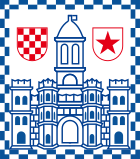
After World War II, Split became a part of the
The shipbuilding industry was particularly successful and Yugoslavia, with its
Since independence
When Croatia declared its independence again in 1991, Split had a large garrison of JNA troops (drafted from all over Yugoslavia), as well as the headquarters and facilities of the Yugoslav War Navy (JRM). This led to a tense months-long stand-off between the JNA and Croatian National Guard and police forces, occasionally flaring up in various incidents. The most tragic such incident occurred on 15 November 1991, when the JRM light frigate Split fired a small number of shells at the city and its surroundings. The damage was insignificant but there were a few casualties. Three general locations were bombarded: the old city center, the city airport and an uninhabited part of the hills above Kaštela, between the airport and Split. JRM Sailors who had refused to attack Croat civilians, most of them Croats themselves, were left in the vessel's brig. The JNA and JRM evacuated all of its facilities in Split during January 1992. The 1990s economic recession soon followed.
In the years following 2000, Split finally gained momentum and started to develop again, with a focus on tourism. From being just a transition centre, Split is now a major Croatian tourist destination. Many new hotels are being built, as well as new apartment and office buildings. Many large development projects are revived, and new infrastructure is being built. An example of the latest large city projects is the Spaladium Arena, built in 2009.
See also
References
- ISSN 0473-0992.
- ^ a b Novak 1957, pp. 13–14.
- ^ Novak 1957, p. 18.
- ^ John Everett-Heath. "Dalmatia." Concise Dictionary of World Place-Names. Oxford University Press. 2005. Encyclopedia.com
- ^ Gibbon, Edward. The Decline and Fall of the Roman Empire. New York: Modern Library. p. 335.
- ^ Novak 1957, p. 30.
- ^ Novak 1957, pp. 35–36.
- ^ Map, The Megalithic Portal and Megalith. "Diocletian's Palace". The Megalithic Portal.
- OCLC 7584841.
- ^ "Diocletian's Palace". W3.mrki.info. Retrieved 6 May 2009.
- ^ Novak 1957, p. 36.
- ^ a b John Gardner Wilkinson (1848). "(Spalato)". Dalmatia and Montenegro. London: J. Murray.
- ^ J. B. Bury, History of the Later Roman Empire, § 4, p. 408.
- ^ Bury (1923), Vol. II, Ch. XVIII, p. 174
- ^ Procopius, De Bello Gothico I.VII
- ^ Novak 1957, pp. 26–27.
- ^ Historia Salonitanorum atque Spalatinorum pontificum [History of the Bishops of Salona and Split] (in Latin). Amsterdam: Johannes Lucius(published 1666).
- ^ a b c d e f g h i j Thomas Graham Jackson (1887). "Spalato". Dalmatia. Oxford: Clarendon Press.
- ^ ISBN 0-472-08149-7.
- ^ Split, Encyclopædia Britannica
- ^ a b c d Novak 2004a, pp. 48–50.
- ^ David Luscombe, Jonathan Riley-Smith: The New Cambridge Medieval History IV, c.1024 – c.1198 part II, p. 272
- ^ "WHKMLA : History of Dalmatia, 614-802". www.zum.de.
- ^ a b Šišić, p. 153.
- ^ "WHKMLA : History of Croatia, 1301–1526". www.zum.de.
- ^ Novak 1957, p. 254.
- ^ Novak 1957, pp. 254–258.
- ^ Novak 1957, pp. 258–259.
- ^ Novak 1961, p. 264.
- ^ Novak 1961, p. 311.
- ^ Novak 1965, p. 8.
- ^ Novak 1965, pp. 39–40.
- ^ "WHKMLA : History of the Illyrian Provinces, 1797–1815". www.zum.de.
- ^ Novak 1965, pp. 47–48.
- ^ Novak 1965, pp. 85–86.
- ^ Novak 1965, pp. 87–88.
- ^ Nikola Anić: Povijest Osmog dalmatinskog korpusa Narodnooslobodilačke vojske Hrvatske : 1943.-1945., p. 12
- ISBN 9788820423780. Retrieved 18 May 2016.
- ^ ISBN 978-88-6134-780-9. Retrieved 22 May 2016.
- ^ 1941. - Prva ratna godina [1941. - The first war year]. Udruga antifašističkih boraca i antifašista grada Splita. Retrieved 14 September 2014.
{{cite book}}:|website=ignored (help) - ISBN 0-253-34656-8
- ISBN 978-0-8147-9378-7.
- ^ Franco Paolo
- ^ Vita e morte del soldato italiano nella guerra senza fortuna - Ed. Ferni Ginevra 1971 Vol. XII
- ISBN 9780230297685. Retrieved 16 February 2022.
Sources
- Novak, Grga (1957). Povijest Splita. Vol. I. Split: Matica Hrvatska.
- Novak, Grga (1961). Povijest Splita. Vol. II. Split: Matica Hrvatska.
- Novak, Grga (1965). Povijest Splita. Vol. III. Split: Matica Hrvatska.
- Novak, Grga (2004a). Prošlost Dalmacije. Vol. I. Split: Marjan Tisak. ISBN 953-214-181-2.
- Novak, Grga (2004b). Prošlost Dalmacije. Vol. II. Split: Marjan Tisak. ISBN 953-214-182-0.
- Šišić, Ferdo. Povijest Hrvata; pregled povijesti hrvatskog naroda 600. - 1918. Zagreb.[publisher missing][year missing]





